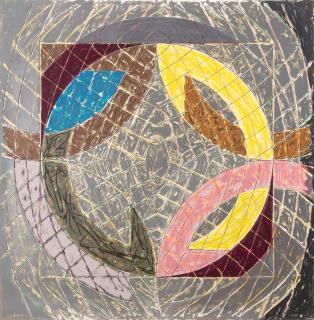Larry Rivers 1923 - 2002
The artist Larry Rivers
- US pop artist who went through several style changes.
- First studied music and made a name for himself as a jazz saxophonist.
- One of the most famous works is a reinterpretation of »Washington Crossing the Delaware«.
American artist Larry Rivers was born Yitzhok Loiza Grossberg in New York City in 1923. Today he is best known for his contributions to the Pop Art movement and is considered one of the early pioneers of the genre.
Rivers was also a musician - after performing as a jazz saxophonist from 1940, he studied at the Juilliard School of Music from 1945 to 1946. There he adopted the pseudonym Larry Rivers, by which he is still known today. During this time, the young musician also developed an interest in painting, which led him to study at the Hans Hofmann School (1947-1948) and at New York University (1949-1951), where he was taught by the abstract expressionist William Baziotes.
Although Rivers initially identified with this style, figurative painting found its way into his work shortly before the end of this second course of study. In the following decade, he also turned to sculpture - sculptures in plaster, metal, and cement began to play a role in Rivers' oeuvre. Then came Pop Art: assemblages of mass-produced objects (packaging, banknotes) - with these techniques and his style, he was officially assigned to the New York School.
In the early 1960s, the budding Pop Art star spent a brief period in Paris, where he collaborated with the kinetic artist Jean Tinguely. In 1967, Rivers stayed in London to work with the photorealist painter and printmaker Howard Kanovitz. During this decade, the artist again changed his technique, using materials such as wood and cardboard and incorporating electric light. He participated in documenta III in 1964 and in the 4th documenta in 1968.
In the 1970s, Rivers changed again: spray cans and airbrush were increasingly part of his toolkit, and he finally turned to video and film art. His malleability was well received by the art world, and he was shown again at the 1977 documenta.
Rivers also gained recognition for his controversial and provocative works. One of his most famous works is Washington Crossing the Delaware, a reinterpretation of the historic painting by Emanuel Leutze. In his version, Rivers included various contemporary figures, including himself, as a commentary on the state of American society. Rivers died in New York on August 14, 2002, just 3 days shy of his 79th birthday.
Der Künstler Larry Rivers
- US-amerikanischer Pop-Art-Künstler, der mehrere Stilwechsel durchlief.
- Studierte zuerst Musik und machte sich als Jazz-Saxophonist einen Namen.
- Ein bekanntes Werk ist die Neuinterpretation von »Washington Crossing the Delaware«.
Der US-amerikanische Künstler Larry Rivers kam 1923 als Yitzhok Loiza Grossberg in New York City auf die Welt. Heute ist er vor allem für seine Beiträge zur Pop-Art-Bewegung bekannt und gilt als einer der frühen Pioniere dieses Genres.
Rivers war auch Musiker – nachdem er bereits ab 1940 als Jazz-Saxophonist aufgetreten war, studierte er von 1945 bis 1946 an der Juilliard School of Music. Dort nahm er das Pseudonym Larry Rivers an, unter dem er auch heute noch bekannt ist. Schon währenddessen interessierte sich der junge Musiker auch für die Malerei und so schloss er direkt ein Studium an der Hans Hofmann School (1947 bis 1948) und an der New York University (1949 bis 1951) an, wo ihn der abstrakte Expressionist William Baziotes unterrichtete.
Zwar identifizierte sich Rivers folglich zunächst auch mit der Stilrichtung, doch schon kurz vor Ende dieses Zweitstudiums fand die figurative Malerei Einzug in sein Werk. Im folgenden Jahrzehnt wandte er sich außerdem der Bildhauerei zu – Skulpturen aus Gips, Metall und Zement spielten fortan eine Rolle in Rivers’ Œuvre. Dann kam die Pop-Art ins Spiel: Assemblagen aus Massenartikeln (Verpackungen, Banknoten) – mit diesen Techniken und seinem Stil zählte man ihn offiziell zur New York School.
Zu Beginn der 1960er Jahre verbrachte der angehende Pop-Art-Star eine kurze Zeit in Paris, wo er mit dem kinetischen Künstler Jean Tinguely zusammenarbeitete. 1967 hielt Rivers sich in London auf, um mit dem fotorealistischen Maler und Grafiker Howard Kanovitz zu kollaborieren. In diesem Jahrzehnt änderte der Künstler seine Technik erneut: Er griff auf Materialien wie Holz und Karton zurück und integrierte auch elektrisches Licht. 1964 war er auf der documenta III und 1968 auch auf der 4. documenta vertreten.
Die 1970er Jahre bescherten Rivers wieder einen Wandel: Spraydosen und Airbrush zählten zunehmend zu seinem Instrumentarium und schließlich wandte er sich auch der Video- und Filmkunst zu. Seine Wandelbarkeit kam in der Kunstwelt gut an, sodass er 1977 erneut auf der documenta zu sehen war.
Rivers erlangte auch Anerkennung für seine kontroversen und provokativen Werke. Eines seiner bekanntesten Werke ist Washington Crossing the Delaware, eine Neuinterpretation des historischen Gemäldes von Emanuel Leutze. In seiner Version fügte Rivers verschiedene zeitgenössische Figuren, darunter auch sich selbst, als Kommentar zum Zustand der amerikanischen Gesellschaft ein. Rivers starb am 14. August 2002 in New York, nur 3 Tage vor seinem 79. Geburtstag.






































